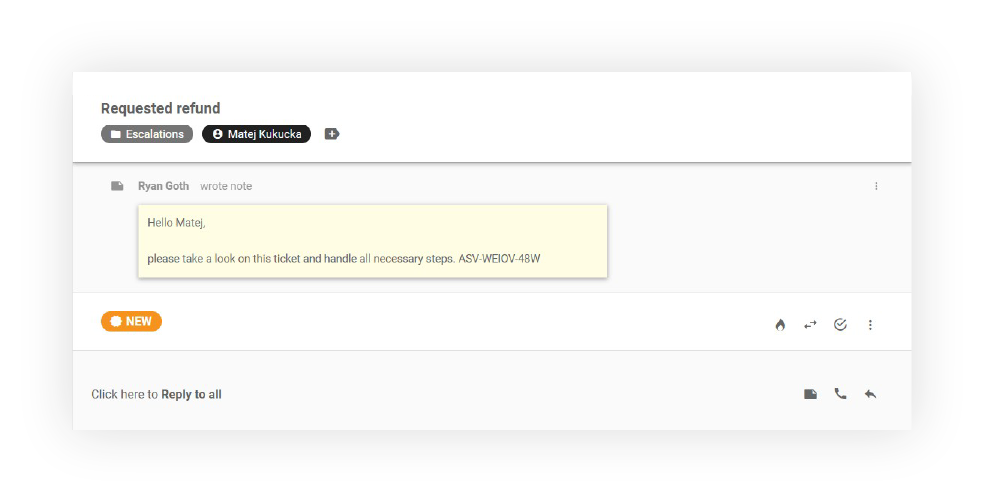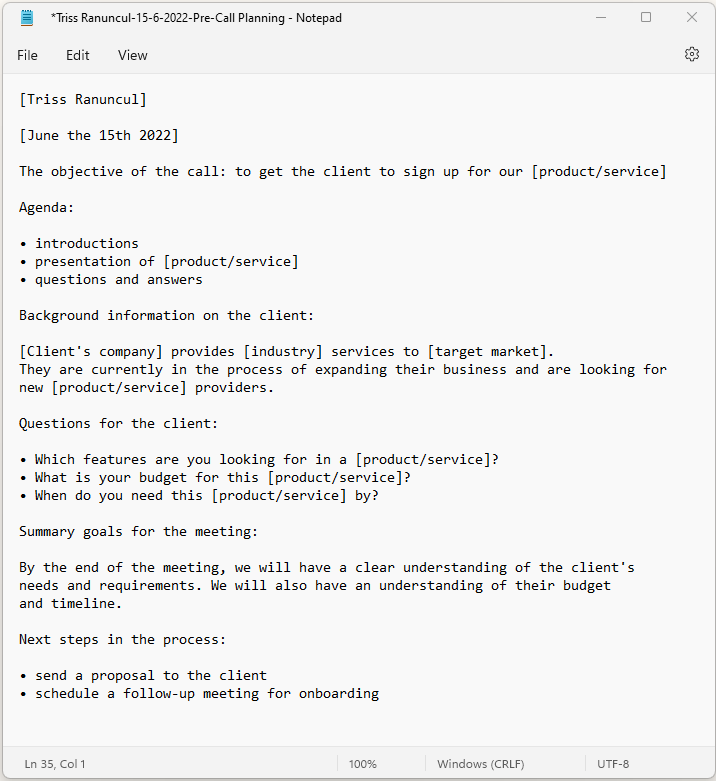对会见客户感到毫无准备?如果是这样,您并不孤单。
许多企业主没有花时间为他们的会面做适当的准备,这可能会浪费大量的时间和精力。
今天,我们将讨论如何最好地计划与潜在客户的会面,这样您就能最大限度地利用每一次会面。
呼叫前计划的重要性
通过花时间适当地准备您的会议,您将能够使每一次会议都尽可能地富有成效和效率。呼叫前计划可以让您与客户建立更好的关系,因为您会更好地了解他们的需求。
通过呼叫前计划,您可以识别客户可能存在的任何潜在反对意见,并在会议前解决它们。尽管呼叫前计划可能会占用您一些额外的时间,但从长远来看,它会通过消除无效率的会面来节省您的时间。
如何给呼叫前计划电子邮件命名
当您在做呼叫前计划时,有一个清晰简洁的笔记系统是很重要的。一种方法是在您的笔记上写上会议的日期和时间,以及客户的名字。这将帮助您记录您的会议记录,并为每次会议做好准备。

您可能需要从与不同客户或项目相关的许多模板中筛选出来,所以在笔记上写上日期可以帮助您快速确定哪些模板与每次会议相关。
而且,因为您要把会议记录发给您的团队、同事、销售团队,甚至只是您自己,所以最好在会议记录的主题行中写上会议标题,这样每个人之后都能很容易地找到它们。
呼叫前计划电子邮件主题行示例
- 潜在客户会议 – [客户姓名] [通话日期]
- 会前计划 – [通话日期] [客户姓名]
- [客户姓名] [通话日期] |通话前规划
- 通话前计划 [客户姓名] [通话日期]
- 与[客户姓名]的预期会议[通话日期]
- 规划阶段 [客户姓名] [通话日期]
- 行动计划 [客户姓名] [通话日期]
- [客户姓名] [通话日期] – 会前讨论
如何编写呼叫前计划模板
呼叫前的计划并不复杂。事实上,它可以像创建一个您想问客户的关键问题的列表一样简单。有这样一个计划,您就能确保每次会议都是有重点的和富有成效的。
从打电话的目的开始。您希望完成什么,如何去做?这会让您确定电话的主要目标,并把每个问题都集中在实现这些目标上。
创建一个议程。您想在电话中讨论什么话题?为什么?这将有助于保持会议的正题,防止您被其他话题打断。

准备一些客户的背景信息。这可以包括从公司历史到当前项目的任何内容。您还应该列出潜在客户可能会问的问题。有了这些信息,您就能更好地了解他们的需求,以及如何帮助他们。
列出您想问客户的问题,可以是澄清他们的需求,也可以是了解他们的预算。这将有助于保持会议的重点和富有成效。
最后,为会议设定总结目标。您希望在通话结束时达成什么目标?这将让您衡量会议的成功程度,并确定接下来的步骤。
呼叫前计划模板中应该包括哪些内容
- 通话目的
- 议程
- 客户的背景信息
- 向客户提出的问题
- 会议目标概要
- 该过程的后续步骤
呼叫前规划模板和示例
潜在客户会议-[客户姓名][呼叫日期]
[Client’s Name]
[Date of Call]
The objective of the call: to discuss the possibility of working together on [Project Name].
Agenda:
• introductions
• discuss project scope
• questions and answers
Background information on the client:
[Client’s company] is a [company size] company that specializes in [industry]. They are currently working on a [project type] project called [Project Name].
Questions for the client:
• What is your budget for this project?
• What is the timeline for this project?
• What are your objectives for this project?
Summary goals for the meeting:
By the end of the meeting, we will have a clear understanding of the project scope and objectives. We will also have an understanding of the client’s budget and timeline.
Next steps in the process:
• send a proposal to the client
• schedule a follow-up meeting to discuss the proposal
会前计划-[呼叫日期][客户姓名]
[Date of Call]
[Client’s Name]
The objective of the call: new arrangements for [project]
Agenda:
• introductions
• current situation
• questions and answers
Background information on the client:
[Company name] has been our client for [time period]. They are currently working on a [project type] project and would like to change the [project details].
Questions for the client:
• How should we proceed with the changes?
• Which team members should be involved in the project?
• What is the timeline for the project?
Summary goals for the meeting:
By the end of the meeting, we will have a clear understanding of how to proceed with the changes and which team members should be involved. We will also have an understanding of the timeline for the project.
[客户名称][呼叫日期] | 呼叫前规划
[Client’s Name]
[Date of Call]
The objective of the call: to get the client to sign up for our [product/service]
Agenda:
• introductions
• presentation of [product/service]
• questions and answers
Background information on the client:
[Client’s company] provides [industry] services to [target market]. They are currently in the process of expanding their business and are looking for new [product/service] providers.
Questions for the client:
• Which features are you looking for in a [product/service]?
• What is your budget for this [product/service]?
• When do you need this [product/service] by?
Summary goals for the meeting:
By the end of the meeting, we will have a clear understanding of the client’s needs and requirements. We will also have an understanding of their budget and timeline.
Next steps in the process:
• send a proposal to the client
• schedule a follow-up meeting for onboarding
[客户姓名][呼叫日期]-会前讨论
[Client’s Name]
[Date of Call]
The objective of the call: discuss possible solutions for [existing project]
Agenda:
• introductions
• current situation
• questions and answers
Background information on the client:
[Client’s company] delivers [industry] services to [target market]. They are currently working on a project called [Project Name] and are facing some challenges. They were a client of ours previously, and we successfully completed a project called [Past Project Name].
Questions for the client:
• What are the challenges you are facing with the current project?
• Do you have a budget for the new project?
• Which team members are working on this project?
Summary goals for the meeting:
By the end of the meeting, we should get a clear understanding of the challenges the client is facing in sending a proposal. We will also know about the client’s budget and timeline.
Next steps in the process:
• sorting out the renewal of the collaboration
• gathering more information about the project during the debrief
呼叫前规划[客户名称][呼叫日期]
[Client’s Name]
[Date of Call]
The objective of the call: to provide a proposal for [Project Name]
Agenda:
• introductions
• presentation of proposal
• questions and answers
Background information on the client:
[Client’s company] is a leader in the [industry] industry. They have been our client for [X] months/years, and are thinking of upgrading their [product/service].
Questions for the client:
• What are your thoughts on the proposal?
• Do you have any questions about the proposal?
• When would you like to start the project?
Summary goals for the meeting:
By the end of the meeting, we should have a few more details established about the project. We will know when they would like to start and have an idea about their thoughts on the proposal.
Next steps in the process:
• send a contract to the client
• schedule a meeting for signing the contract
与[客户姓名][呼叫日期]的预期会面
[Client’s Name]
[Date of Call]
The objective of the call: to sign the contract for [Project Name]
Agenda:
• introductions
• review of the contract
• questions and answers
Background information on the client:
[Client’s company] is a leader in the sector of [industry]. They have been our client for [time period], and we have completed a few projects together during that time. The most recent one was called [Project Name].
Questions for the client:
• Do you have any questions about the contract?
• When would you like to start the project?
Summary goals for the meeting:
By the end of the meeting, we will have a signed contract for the project. We should also know when they would like to start the project.
Next steps in the process:
• send a welcome pack to the client
• schedule a kickoff meeting with the client’s team
• send an email to the team with background information
规划阶段[客户名称][呼叫日期]
[Client’s Name]
[Date of Call]
The objective of the call: to kick off [Project Name]
Agenda:
• introductions
• review of project goals
• questions and answers
Background information on the client:
[Client’s company] is a leader in their industry, with a focus on [target market]. They have been our client for a few years, and we have completed several different projects together.
Questions for the client:
• How could we improve our collaboration?
• Do you have any questions about the project goals?
Summary goals for the meeting:
By the end of the meeting, we should have a clear understanding of the client’s expectations. We will also know what their thoughts are on how we can improve our collaboration.
Next steps in the process:
• send a thank you email to the client
• schedule regular check-in calls with the client’s team
• begin work on the project deliverables
呼叫前计划模板-良好实践
在呼叫前销售计划方面,在与潜在客户通话之前,有几件关键的事情是您应该做的。这包括:
- 查看客户的网站 – 可以为您提供有关他们的业务、目标市场等的大量信息。在通话前计划方面绝对是必须要做的事情。
- 验证他们的社交媒体资料 – 告诉您他们的语气以及他们分享的内容类型等。
- 审查提案 – 阐明您提供的产品以及客户的需求。
- 与您的团队联系 – 询问最近是否有其他人与客户交谈过,以及他们对实际销售对话是否有任何见解。
- 了解客户的预算和时间表 – 调整对话、提出切合实际的建议并设定期望。
- 为客户准备问题 – 为了充分利用通话的效果,请事先列出一些您想问的问题。
- 收集他们公司的背景信息 – 建立融洽的关系并表明您对他们的业务进行了投资。
- 了解他们的行业和目标市场 – 您了解的越多,您对他们的价值就越大,对他们的购买决策就越有影响力。
- 写下客户可能会问您的问题清单 – 销售代理需要做好一切准备,因为客户可能会对您的建议有所顾虑。
- 寻求推荐 – 这是发展公司和获得更多客户的好方法,同时也可以作为社会证明你的事。
- 为会议制定销售电话前行动计划 – 您需要为电话会议制定明确而坚定的目标,并了解您想要实现的目标。
- 制定后续计划 – 通话结束后,您应该知道下一步该做什么。它可以是发送提案、安排另一次会议,或者只是保持联系。
- 通话后发送“谢谢”便条 – 对您的潜在客户抽出时间表示感谢并向他们发送讨论内容的回顾。如果您有任何他们可能认为有用的其他信息,请务必附上。

总结
呼叫前计划是销售过程中必不可少的一部分,它可以帮助您最大限度地与潜在客户会面。花时间研究您的潜在客户,了解他们的需求,为会议制定一个可靠的计划。您将增加成功销售的机会。
Jumpstart your phone sales with LiveAgent!
Start your free 30-day trial and improve your sales pitches with our ticketing and cloud-call center features.
Frequently Asked Questions
呼叫前计划是如何工作的?
目标是为与潜在客户的销售会议做准备。这包括研究客户,他们的需求,以及他们所在的行业。呼叫前计划还包括制定一个完整的销售电话策略,包括相关问题和支持销售工作的其他活动,所有这些都是为了有效的销售电话和整体业务活动。
为什么呼叫前计划对商业至关重要?
您会更好地准备销售您的产品或服务。这是因为,在您的销售谈话中,您会更好地理解客户的需求,以及您如何帮助解决他们的问题。此外,呼叫前计划可以让您与潜在客户建立融洽的关系,并建立信任。
如何开始呼叫前计划?
在与潜在客户通话之前,每个销售人员都应该制定一个销售计划,包括要问什么样的问题,以及什么样的开场白最有效。一定要检查您的提案,并清楚地了解客户的预算和时间表。最后,制定一个令人无法抗拒的销售说辞。
是什么让呼叫前计划成功?
有几个关键的组成部分:确保销售代表清楚会议的目的和他们希望达到的目标。提前做好调查,这样您就可以为购买过程中出现的任何情况做好准备,并在会议结束后与客户联系,感谢他们抽出时间。向他们发送任何他们认为有用的额外信息,并询问任何在销售电话中没有解决的关键问题。
您是否应该在呼叫前计划模板中添加附件?
您可以,但没有必要。如果您有任何对会议或整个销售策略有帮助的额外信息,请随意将其包含在模板中。但是,附件不是必需的,如果需要,可以单独发送。
呼叫前的计划模板需要很长吗?
不,呼叫前计划模板可以随您的需要而变长或变短。重要的是,他们包括所有必要的信息,以准备一个成功的会议。有时候,时间越短越好,因为它可以更容易地消化销售周期中的所有信息
有哪些常见的呼叫前计划错误?
最常见的错误之一是销售人员没有对客户做足够的调查。这可能导致他们毫无准备地参加会议,对自己的需求没有清晰的了解。另一个错误是对会后要做什么没有一个可靠的计划,这可能会导致失去机会。准备一些开放式的问题,可以在后续谈话中消除任何疑虑或常见的反对意见。
Explore inspiring success stories of diverse companies using LiveAgent to enhance customer satisfaction, loyalty, and revenue. From global travel agencies like SATUR to innovative startups like FrëschKëscht, discover how businesses thrive with tailored customer support solutions. Start your 14-day free trial today – no credit card required!
You will be
in Good Hands!
Join our community of happy clients and provide excellent customer support with LiveAgent.

我们的网站使用cookies。点击继续我们将默认为您允许我们将cookies部署在我们的网站上。 隐私和cookie政策.

 Български
Български  Čeština
Čeština  Dansk
Dansk  Deutsch
Deutsch  Eesti
Eesti  Español
Español  Français
Français  Ελληνικα
Ελληνικα  Hrvatski
Hrvatski  Italiano
Italiano  Latviešu
Latviešu  Lietuviškai
Lietuviškai  Magyar
Magyar  Nederlands
Nederlands  Norsk bokmål
Norsk bokmål  Polski
Polski  Română
Română  Русский
Русский  Slovenčina
Slovenčina  Slovenščina
Slovenščina  Tagalog
Tagalog  Tiếng Việt
Tiếng Việt  العربية
العربية  English
English  Português
Português 






